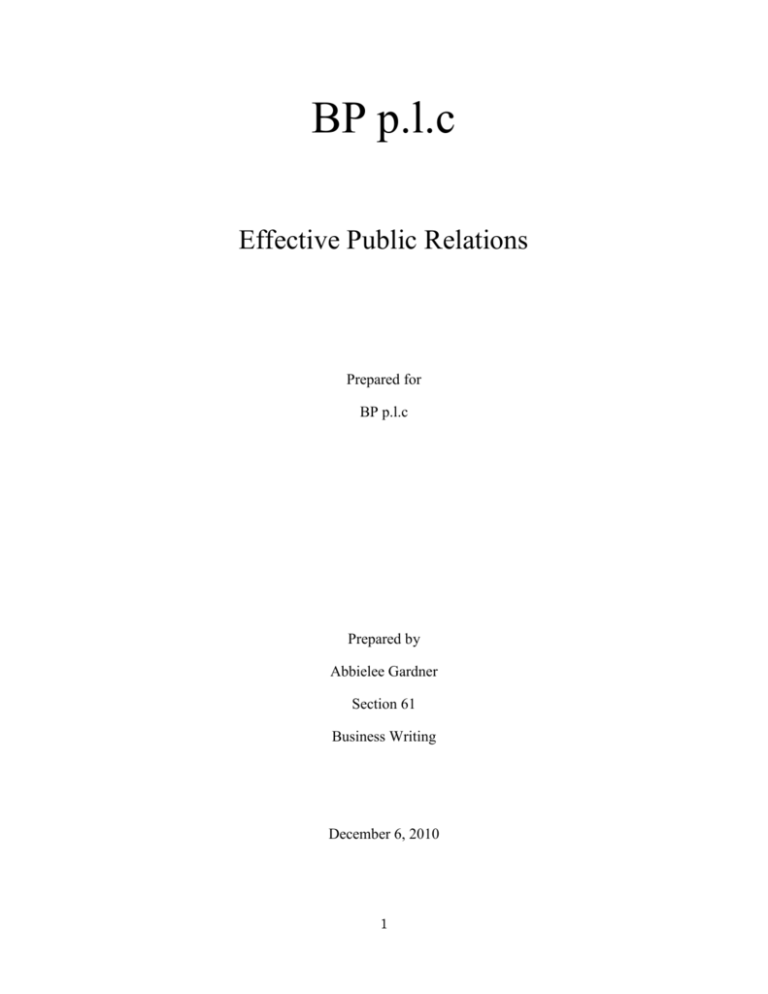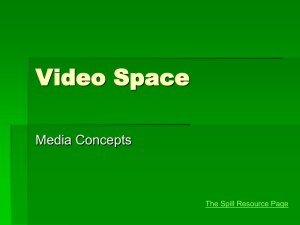BP plc - University of Utah
advertisement

BP p.l.c Effective Public Relations Prepared for BP p.l.c Prepared by Abbielee Gardner Section 61 Business Writing December 6, 2010 1 TABLE OF CONTENTS Executive Summary………………………………………………………………………………3 Introduction………………………………………………………………………………………4 History……………………………………………………………………………………………4 Crisis……………………………………………………………………………………………...5 Lawyers: “Don’t Say Anything”, PR People: “Get your Message out there”……………………5 Tony Hayward……………………………………………………………………………………6 The Problems with Outsourcing………………………………………………………………….7 Recommendations………………………………………………………………………….…….8 Aftermath………………………………………………………………………………………...8 LIST OF ILLUSTRATIONS BP PR cartoon……………………………………………………………………………………5 Tony Hayward Yachting cartoon………………………………………………………………..7 2 BP p.l.c Effective Public Relations Executive Summary In April of 2010, BPs reputation took a major hit when one of its deepwater rigs, working less than 50 miles south of Louisiana, exploded and killed 11 workers. For the next several months millions of gallons of oil rushed into the Gulf of Mexico leaving BP with a public relations nightmare. Knowing that its name and future as a company are at stake, BP must consider its options carefully. BP chose to undertake an aggressive marketing campaign to downplay the effects of the incident. However, this campaign backfired and made the company seem more concerned with profits than ecological impact. With over 200 civil suits and massive government fines, BP chose to handle its legal issues quietly and quickly, leaving the public confused to what was really going on. BP must restore its public image from three directions: 1. Staying silent is not an option - BP must communicate with the public more effectively and let them know what is going on 2. CEO must have some humility - BPs CEO, Tony Hayward, less than a month after the spill, declined or failed to answer 65 questions before Congress and then later that week went on a glitzy yacht race. 3. Take responsibility - Seven months after the spill and BP is continuing to blame others. Although reports have come out that BP never made a choice of dollars over safety and a simple technical error is the blame, it must still fess up and take responsibility. 3 INTRODUCTION The world is no longer a straight line from company to consumer. The first World Assembly of Public Relations Associations in 1978 stated that public relations is "the art of analyzing trends, predicting their consequences, counseling organizational leaders, and implementing planned programs of action, which will serve both the organization and the public interest." This is quite the balancing act for any company. For any crisis, it is like walking on glass without getting cut. HISTORY BP, formerly known as British Petroleum, is the world's third-largest oil company, behind Exxon Mobil and Royal Dutch Shell. BP is also the largest oil and gas producer in the United States, with stakes in 16 refineries. BP processes roughly four million barrels of crude oil every day. BP markets its products in more than 100 countries and operates 22,400 gas stations worldwide. The company's operations primarily include the exploration and production of gas and crude oil, as well as the marketing and trading of natural gas, power, and natural gas liquids.1 BP is a global superpower and when it comes to making money, BP is one of the best. According to its revenue BP is the fourth largest company, once again behind Exxon Mobil and Royal Dutch Shell with Wal-Mart topping off the list.2 However, drilling oil can have its financial and environmental difficulties. In the past two decades BP has made headlines for issues for their concern with the environment or more like the lack of. In 1999 BP was charged with illegally dumping hazardous wastes on the Alaska North Slope, for $22 million. The settlement included the maximum $500,000 criminal fine, $6.5 million in civil penalties.3 In both 2001 and 2005, BP was named by Mother Jones Magazine, who "expose the evils of the corporate world, the government, and the mainstream media," as one of the ten worst corporations based on its environmental record.4 “BP p.l.c” Hoover’s A D&B Company, http://www.hoovers.com/company/BP_plc/hxxkti-1.html, accessed October 31, 2010 2 "Global 500 - Full List”. Fortune. 26 July 2010. http://money.cnn.com/magazines/fortune/global500/2010/full_list/ 3 "BP Exploration Alaska Pleads Guilty To Hazardous Substance Crime Will Pay $22 Million”. United States Environmental Protection Agency. 23 September 1999. http://yosemite.epa.gov/opa/admpress.nsf/016bcfb1deb9fecd85256aca005d74df/5d61856989631e20852567f6004bb bff?OpenDocument. 4 "Ten Worst Corporations of 2000". Motherjones.com. http://www.motherjones.com/news/feature/2001/01/fotc33.html. Accessed November 2, 2010. 1 4 CRISIS Maintaining a good public image for such a superpower is a must. In April of 2010, BPs reputation took a major hit when one of its deepwater rigs, working less than 50 miles south of Louisiana, exploded and killed 11 workers. For the next several months millions of gallons of oil rushed into the Gulf of Mexico leaving BP with a public relations nightmare. "BP must weigh the cost of admitting things that could be used against it later against the cost now of bad publicity," said Michael Siegel, a University of Florida law professor and former federal prosecutor. The aftermath of a disaster such as this can be an immense task and how BP reacts and deals with the public will set the tone for its future as a company. LAWYERS: “DON’T SAY ANYTHING” PR PEOPLE: “GET YOUR MESSAGE OUT THERE” When a crisis happens that makes every headline, a well-coordinated communications strategy can make a difference in determining the public’s perception and reaction. To a nation frustrated by the Gulf coast crisis, BP's strategy to control damage has at some points been vague. But from a legal standpoint, that's exactly the point.5 At BP or at any company for that matter there is a natural tension between public relations people who want BP to project a positive image and lawyers who don't want to be pushed into a corner. With the company facing more than 200 civil lawsuits and numerous investigations, saying something wrong could expose BP to millions of dollars in damages or even criminal charges for its executives. Anderson, Curt, et al. “BP Public Relations Strategy no surprise- to Lawyers” Associated Press http://www.salon.com/news/louisiana_oil_spill/index.html?story=/news/feature/2010/06/23/bp_pr_strategy_no_surp rise_to_lawyers 5 5 Beyond the remarks that have made headlines, BP has carefully chosen its words. For example, BP has spoken of paying "legitimate" claims for economic damages without saying what exactly legitimate means.6 On the other hand failing to disclose all the facts can be harmful too. Two years ago, on the advice of lawyers, Merrill Lynch CEO resisted disclosing details of huge bonuses paid to executives just as the brokerage house was about to report billions in losses. In order to help with this balancing act BP brought in outside PR firms, including the Brunswick Group and Ogilvy Public Relations Worldwide and hired the WilmerHale law firm to handle congressional and Justice Department investigations. WilmerHale's team is led by Jamie Gorelick, a former deputy attorney general in the Clinton administration.7 However, few comments have been made from these firms about BPs strategy. Bruce Blythe, CEO of Crisis Management International, an Atlanta company that represented BP until the late 1990s, said “lawyers and the crisis-management team have to understand they are working toward the same goal: protecting the company's assets, brand and reputation. It's just that their approaches often contradict each other. This is an age-old problem between the attorneys who say 'Don't say anything' and the public-relations people who want you to get your message out.” At this point communicating to the public is essential. Exxon Mobil failed at messaging in 1989, during the Exxon Valdez crisis. Blythe explained, “It took the CEO at the time, Larry Rawls, three weeks to get on TV. There was a sense that Exxon didn't care and didn't want to take responsibility. To this day, there are people who will not go to an Exxon station, BP's looking at the same kind of thing." TONY HAYWARD In May of 2007 Tony Hayward became Chief Executive Officer of BP, but this career proved to be short lived. His decline is due solely to his response to the oil spill. Hayward has been caught stating many insensitive comments regarding the Gulf oil spill. For example, he apologized for the crisis but still managed to make it about him, “I'm sorry. We're sorry for the massive disruption it's caused their lives. There's no one who wants this over more than I do. I'd like my life back.” Hayward has also been criticized for downplaying the size of the spill when he called the spill "relatively tiny." The spill is now by far the worst oil spill in U.S. history. Aside from his comments some of his actions have proved to be dim viewed such as less than a month after the spill Hayward was yachting off the coast of England. Following the oil spill, there were rumors that Hayward would resign, but the company dismissed these. A BP press release stated that Hayward "has the full confidence of the Board of Directors of BP." However, on July 27, 2010 BP confirmed that Hayward would be replaced by Bob Dudley as the company's CEO.8 Anderson, Curt, et al. “BP Public Relations Strategy no surprise- to Lawyers” Associated Press http://www.salon.com/news/louisiana_oil_spill/index.html?story=/news/feature/2010/06/23/bp_pr_strategy_no_surp rise_to_lawyers 7 Anderson, Curt, et al. “BP Public Relations Strategy no surprise- to Lawyers” 8 "American Bob Dudley Takes Helm At BP". Sky News. 27 July 2010. http://news.sky.com/skynews/Home/Business/Bob-Dudley-Expected-To-Take-Over-From-Tony-Hayward-As-NewBP-Chief-Executive/Article/201007415671034. Retreived December 3, 2010 6 6 THE PROBLEM WITH OUTSOURCING When a company does not have the resources to complete a task it tends to hire someone outside the company to complete it. That is exactly what BP did. BP hired Transocean and Halliburton. Transocean is the world’s largest offshore drilling contractor. It rents drill rigs, along with the equipment for operations, to oil and gas companies at an average daily rate of $142,000.9 Halliburton is the world's second largest oilfield services corporation. It provides technical products and services for petroleum and natural gas exploration and production.10 The problem with outsourcing tasks is if something goes wrong who is liable. In this case BP, Transocean and Halliburton are all blaming each other. “Transocean’s blowout preventer failed to operate,” Lamar McKay, chairman of BP America Inc., said in testimony prepared for a Senate Energy Committee hearing. Executives representing Transocean, owner of the Deepwater Horizon rig that exploded, and Halliburton, which provided cement for the oil well, have said that BP had the lead decision-making role.11 Even President Obama has become tired of no one taking responsibility stating, "You had executives of BP and Transocean and Halliburton falling over each other to point the finger of blame at somebody else. The American people cannot have “Transocean” Wikinvest http://www.wikinvest.com/wiki/Transocean_%28RIG%29 retrieved December 1, 2010 “Company Profile” http://zenobank.com/index.php?symbol=HAL&page=quotesearch retrieved December 2, 2010 11 Efstathiou, Jim. “BP, Halliburton, Transocean Blame Each Other in Gulf Oil Spill” (May, 2010) Bloomberg BusinessWeek. http://www.businessweek.com/news/2010-05-10/bp-halliburton-transocean-blame-each-other-ingulf-oil-spill.html 9 10 7 been impressed with that display, and I certainly wasn't. I will not tolerate more finger pointing or irresponsibility.”12 RECOMMENDATIONS Seven months after the oil spill, BPs public image has taken a huge hit. Restoring its public credibility BP must at the very least do three things. First BP cannot stay silent. Since the beginning of the disaster, just about every element of crisis has been covered in secrecy. From the size of the spill, to the unprecedented amount of dispersant BP used to hide the oil, the oil spill has been about BP trying to limit their financial liability. Time and time again “no comment” has been the only thing said by BP executives and spokespeople. BP must communicate with the public more effectively and let them know what is going on. Second, BPs CEO must have some humility and compassion. BPs CEO, Tony Hayward, less than a month after the spill, declined or failed to answer 65 questions before Congress and then later that week went on a glitzy yacht race. Nothing looks worse to the public then high paid executives living the life while gulf coast residents are left with cleaning up there shattered lives. Last BP must take responsibility. Seven months after the spill and BP is continuing to blame others. BP officials tried to blame the initial explosion on rig owner, Transocean, and Halliburton, who was hired for maintenance and to cement the well pipes at BP's direction. In early May, Hayward said, "The rig that exploded on April 20 and then sank was run by another company, Transocean. That rig "was run by their people, their processes." Although reports have come out that BP never made a choice of dollars over safety and a simple technical error is the blame, it must still fess up and take responsibility. AFTERMATH The Gulf of Mexico oil spill has been declared as the largest accidental oil spill in the petroleum industry history. To this day the spill continues to cause extensive damage to marine and wildlife habitats as well as the Gulf's fishing and tourism industries. To pay for the oil spill, BP announced in late June 2010 that it plans to cut dividend payments and capital expenditures. After meeting with White House officials, BP officials announced that the company will Montopoli, Brian. “Obama Slams BP, Transocean, Halliburton Over Gulf Oil Spill” CBS News. http://www.cbsnews.com/8301-503544_162-20005013-503544.html 12 8 establish a $20 billion fund to compensate victims of the Gulf oil disaster. BP developed a payment system that has the potential of paying out the $20 billion by the end of 2013. 13 As of September 8, 50,000 claims, 44,000 of those for lost income, had been filed. Over 10,000 claims had been paid, totaling nearly $80 million. There has been a great deal of criticism of BP both in the US and worldwide for its role in the oil spill. By June, the Facebook page "Boycott BP," started by Lee Perkins, had over 688,500 "likes" from Facebook users. An opinion poll conducted by ABC News in early June found that nearly three-fourths of Americans considered the spill a major environmental disaster. Of those polled, 81 percent viewed the BP response negatively and 69 percent viewed the federal government response negatively. Sixty-four percent of those polled expressed support for criminal prosecution of BP.14 Reactions to the oil spill have ranged from blame and anger at the damage caused by the spill, to calls for greater accountability on the part of the U.S. government and BP, including new legislation dealing with preventative security and cleanup improvements. Gelsi, Steve, et al. “BP OKs $20 billion spill fund; suspends dividend” (June, 16 2010) http://www.marketwatch.com/story/bp-quiet-on-escrow-demand-before-obama-meeting-2010-06-16 14 Cohen, Jon (7 June 2010). "Behind the Numbers: Poll shows negative ratings for BP, federal government". Washington Post. http://voices.washingtonpost.com/behind-thenumbers/2010/06/poll_shows_negative_ratings_fo.html. Retrieved November 30,2010 13 9








